QWizard Class Reference
|
|
- 2 properties inherited from QDialog
- 57 properties inherited from QWidget
- 1 property inherited from QObject
Public Functions
- QWizard ( QWidget * parent = 0, Qt::WindowFlags flags = 0 )
- ~QWizard ()
- int addPage ( QWizardPage * page )
- QAbstractButton * button ( WizardButton which ) const
- QString buttonText ( WizardButton which ) const
- int currentId () const
- QWizardPage * currentPage () const
- QVariant field ( const QString & name ) const
- bool hasVisitedPage ( int id ) const
- virtual int nextId () const
- WizardOptions options () const
- QWizardPage * page ( int id ) const
- QPixmap pixmap ( WizardPixmap which ) const
- void setButton ( WizardButton which, QAbstractButton * button )
- void setButtonLayout ( const QList<WizardButton> & layout )
- void setButtonText ( WizardButton which, const QString & text )
- void setDefaultProperty ( const char * className, const char * property, const char * changedSignal )
- void setField ( const QString & name, const QVariant & value )
- void setOption ( WizardOption option, bool on = true )
- void setOptions ( WizardOptions options )
- void setPage ( int id, QWizardPage * page )
- void setPixmap ( WizardPixmap which, const QPixmap & pixmap )
- void setStartId ( int id )
- void setSubTitleFormat ( Qt::TextFormat format )
- void setTitleFormat ( Qt::TextFormat format )
- void setWizardStyle ( WizardStyle style )
- int startId () const
- Qt::TextFormat subTitleFormat () const
- bool testOption ( WizardOption option ) const
- Qt::TextFormat titleFormat () const
- virtual bool validateCurrentPage ()
- QList<int> visitedPages () const
- WizardStyle wizardStyle () const
- 5 public functions inherited from QDialog
- 206 public functions inherited from QWidget
- 29 public functions inherited from QObject
- 14 public functions inherited from QPaintDevice
Public Slots
- 4 public slots inherited from QDialog
- 19 public slots inherited from QWidget
- 1 public slot inherited from QObject
Signals
- void currentIdChanged ( int id )
- void customButtonClicked ( int which )
- void helpRequested ()
Protected Functions
- virtual void cleanupPage ( int id )
- virtual void initializePage ( int id )
- 38 protected functions inherited from QWidget
- 7 protected functions inherited from QObject
- 1 protected function inherited from QPaintDevice
Additional Inherited Members
- 4 static public members inherited from QWidget
- 5 static public members inherited from QObject
- 1 protected slot inherited from QWidget
Detailed Description
The QWizard class provides a framework for wizards.
A wizard (also called an assistant on Mac OS X) is a special type of input dialog that consists of a sequence of pages. A wizard's purpose is to guide the user through a process step by step. Wizards are useful for complex or infrequent tasks that users may find difficult to learn.
QWizard inherits QDialog and represents a wizard. Each page is a QWizardPage (a QWidget subclass). To create your own wizards, you can use these classes directly, or you can subclass them for more control.
Topics:
- A Trivial Example
- Wizard Look and Feel
- Elements of a Wizard Page
- Registering and Using Fields
- Creating Linear Wizards
- Creating Non-Linear Wizards
A Trivial Example
The following example illustrates how to create wizard pages and add them to a wizard. For more advanced examples, see Class Wizard and License Wizard.
QWizardPage *createIntroPage()
{
QWizardPage *page = new QWizardPage;
page->setTitle("Introduction");
QLabel *label = new QLabel("This wizard will help you register your copy "
"of Super Product Two.");
label->setWordWrap(true);
QVBoxLayout *layout = new QVBoxLayout;
layout->addWidget(label);
page->setLayout(layout);
return page;
}
QWizardPage *createRegistrationPage()
{
...
}
QWizardPage *createConclusionPage()
{
...
}
int main(int argc, char *argv[])
{
QApplication app(argc, argv);
QString translatorFileName = QLatin1String("qt_");
translatorFileName += QLocale::system().name();
QTranslator *translator = new QTranslator(&app);
if (translator->load(translatorFileName, QLibraryInfo::location(QLibraryInfo::TranslationsPath)))
app.installTranslator(translator);
QWizard wizard;
wizard.addPage(createIntroPage());
wizard.addPage(createRegistrationPage());
wizard.addPage(createConclusionPage());
wizard.setWindowTitle("Trivial Wizard");
wizard.show();
return app.exec();
}
Wizard Look and Feel
QWizard supports four wizard looks:
You can explicitly set the look to use using setWizardStyle() (e.g., if you want the same look on all platforms).
| ClassicStyle | ModernStyle | MacStyle | AeroStyle |
|---|---|---|---|
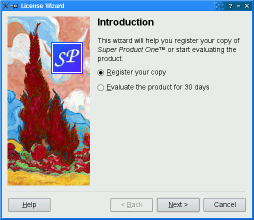 | 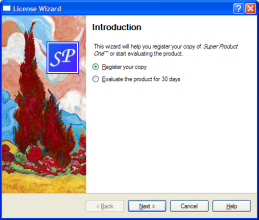 | 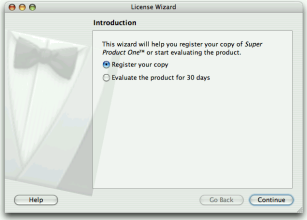 | 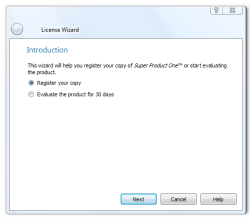 |
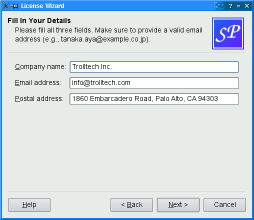 | 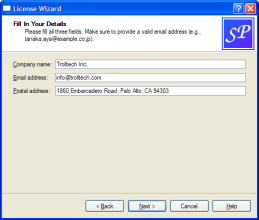 | 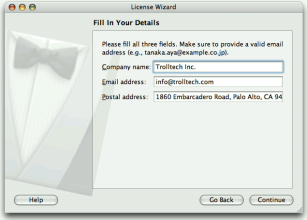 | 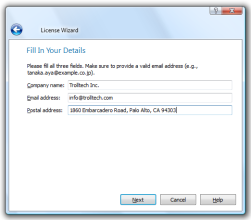 |
Note: AeroStyle has effect only on a Windows Vista system with alpha compositing enabled. ModernStyle is used as a fallback when this condition is not met.
In addition to the wizard style, there are several options that control the look and feel of the wizard. These can be set using setOption() or setOptions(). For example, HaveHelpButton makes QWizard show a Help button along with the other wizard buttons.
You can even change the order of the wizard buttons to any arbitrary order using setButtonLayout(), and you can add up to three custom buttons (e.g., a Print button) to the button row. This is achieved by calling setButton() or setButtonText() with CustomButton1, CustomButton2, or CustomButton3 to set up the button, and by enabling the HaveCustomButton1, HaveCustomButton2, or HaveCustomButton3 options. Whenever the user clicks a custom button, customButtonClicked() is emitted. For example:
wizard()->setButtonText(QWizard::CustomButton1, tr("&Print"));
wizard()->setOption(QWizard::HaveCustomButton1, true);
connect(wizard(), SIGNAL(customButtonClicked(int)),
this, SLOT(printButtonClicked()));
Elements of a Wizard Page
Wizards consist of a sequence of QWizardPages. At any time, only one page is shown. A page has the following attributes:
- A title.
- A subTitle.
- A set of pixmaps, which may or may not be honored, depending on the wizard's style:
- WatermarkPixmap (used by ClassicStyle and ModernStyle)
- BannerPixmap (used by ModernStyle)
- LogoPixmap (used by ClassicStyle and ModernStyle)
- BackgroundPixmap (used by MacStyle)
The diagram belows showns how QWizard renders these attributes, assuming they are all present and ModernStyle is used:
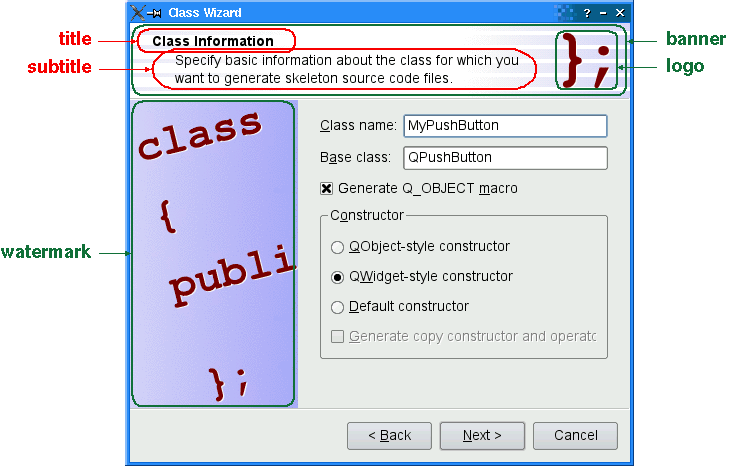
When a subTitle is set, QWizard displays it in a header, in which case it also uses the BannerPixmap and the LogoPixmap to decorate the header. The WatermarkPixmap is displayed on the left side, below the header. At the bottom, there is a row of buttons allowing the user to navigate through the pages.
The page itself (the QWizardPage widget) occupies the area between the header, the watermark, and the button row. Typically, the page is a QWizardPage on which a QGridLayout is installed, with standard child widgets (QLabels, QLineEdits, etc.).
If the wizard's style is MacStyle, the page looks radically different:
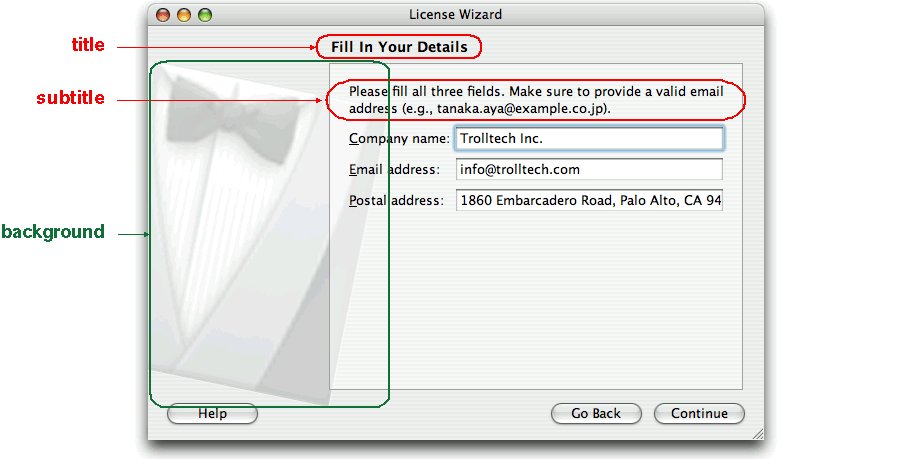
The watermark, banner, and logo pixmaps are ignored by the MacStyle. If the BackgroundPixmap is set, it is used as the background for the wizard; otherwise, a default "assistant" image is used.
The title and subtitle are set by calling QWizardPage::setTitle() and QWizardPage::setSubTitle() on the individual pages. They may be plain text or HTML (see titleFormat and subTitleFormat). The pixmaps can be set globally for the entire wizard using setPixmap(), or on a per-page basis using QWizardPage::setPixmap().
Registering and Using Fields
In many wizards, the contents of a page may affect the default values of the fields of a later page. To make it easy to communicate between pages, QWizard supports a "field" mechanism that allows you to register a field (e.g., a QLineEdit) on a page and to access its value from any page. It is also possible to specify mandatory fields (i.e., fields that must be filled before the user can advance to the next page).
To register a field, call QWizardPage::registerField() field. For example:
ClassInfoPage::ClassInfoPage(QWidget *parent)
: QWizardPage(parent)
{
...
classNameLabel = new QLabel(tr("&Class name:"));
classNameLineEdit = new QLineEdit;
classNameLabel->setBuddy(classNameLineEdit);
baseClassLabel = new QLabel(tr("B&ase class:"));
baseClassLineEdit = new QLineEdit;
baseClassLabel->setBuddy(baseClassLineEdit);
qobjectMacroCheckBox = new QCheckBox(tr("Generate Q_OBJECT ¯o"));
registerField("className*", classNameLineEdit);
registerField("baseClass", baseClassLineEdit);
registerField("qobjectMacro", qobjectMacroCheckBox);
...
}
The above code registers three fields, className, baseClass, and qobjectMacro, which are associated with three child widgets. The asterisk (*) next to className denotes a mandatory field.
The fields of any page are accessible from any other page. For example:
void OutputFilesPage::initializePage()
{
QString className = field("className").toString();
headerLineEdit->setText(className.toLower() + ".h");
implementationLineEdit->setText(className.toLower() + ".cpp");
outputDirLineEdit->setText(QDir::convertSeparators(QDir::tempPath()));
}
Here, we call QWizardPage::field() to access the contents of the className field (which was defined in the ClassInfoPage) and use it to initialize the OuputFilePage. The field's contents is returned as a QVariant.
When we create a field using QWizardPage::registerField(), we pass a unique field name and a widget. We can also provide a Qt property name and a "changed" signal (a signal that is emitted when the property changes) as third and fourth arguments; however, this is not necessary for the most common Qt widgets, such as QLineEdit, QCheckBox, and QComboBox, because QWizard knows which properties to look for.
If an asterisk (*) is appended to the name when the property is registered, the field is a mandatory field. When a page has mandatory fields, the Next and/or Finish buttons are enabled only when all mandatory fields are filled.
To consider a field "filled", QWizard simply checks that the field's current value doesn't equal the original value (the value it had when initializePage() was called). For QLineEdit and QAbstractSpinBox subclasses, QWizard also checks that hasAcceptableInput() returns true, to honor any validator or mask.
QWizard's mandatory field mechanism is provided for convenience. A more powerful (but also more cumbersome) alternative is to reimplement QWizardPage::isComplete() and to emit the QWizardPage::completeChanged() signal whenever the page becomes complete or incomplete.
The enabled/disabled state of the Next and/or Finish buttons is one way to perform validation on the user input. Another way is to reimplement validateCurrentPage() (or QWizardPage::validatePage()) to perform some last-minute validation (and show an error message if the user has entered incomplete or invalid information). If the function returns true, the next page is shown (or the wizard finishes); otherwise, the current page stays up.
Creating Linear Wizards
Most wizards have a linear structure, with page 1 followed by page 2 and so on until the last page. The Class Wizard example is such a wizard. With QWizard, linear wizards are created by instantiating the QWizardPages and inserting them using addPage(). By default, the pages are shown in the order in which they were added. For example:
ClassWizard::ClassWizard(QWidget *parent)
: QWizard(parent)
{
addPage(new IntroPage);
addPage(new ClassInfoPage);
addPage(new CodeStylePage);
addPage(new OutputFilesPage);
addPage(new ConclusionPage);
...
}
When a page is about to be shown, QWizard calls initializePage() (which in turn calls QWizardPage::initializePage()) to fill the page with default values. By default, this function does nothing, but it can be reimplemented to initialize the page's contents based on other pages' fields (see the example above).
If the user presses Back, cleanupPage() is called (which in turn calls QWizardPage::cleanupPage()). The default implementation resets the page's fields to their original values (the values they had before initializePage() was called). If you want the Back button to be non-destructive and keep the values entered by the user, simply enable the IndependentPages option.
Creating Non-Linear Wizards
Some wizards are more complex in that they allow different traversal paths based on the information provided by the user. The License Wizard example illustrates this. It provides five wizard pages; depending on which options are selected, the user can reach different pages.
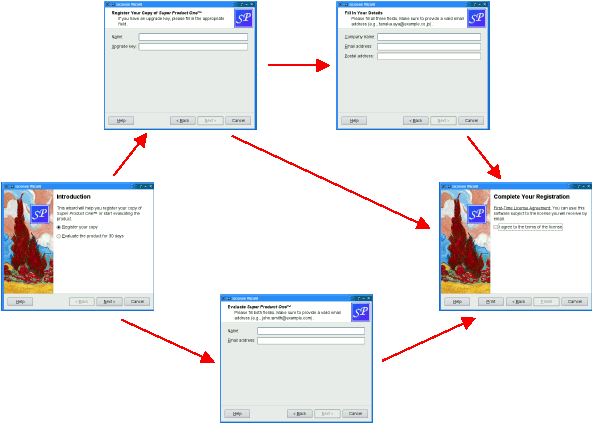
In complex wizards, pages are identified by IDs. These IDs are typically defined using an enum. For example:
class LicenseWizard : public QWizard
{
...
enum { Page_Intro, Page_Evaluate, Page_Register, Page_Details,
Page_Conclusion };
...
};
The pages are inserted using setPage(), which takes an ID and an instance of QWizardPage (or of a subclass):
LicenseWizard::LicenseWizard(QWidget *parent)
: QWizard(parent)
{
setPage(Page_Intro, new IntroPage);
setPage(Page_Evaluate, new EvaluatePage);
setPage(Page_Register, new RegisterPage);
setPage(Page_Details, new DetailsPage);
setPage(Page_Conclusion, new ConclusionPage);
...
}
By default, the pages are shown in increasing ID order. To provide a dynamic order that depends on the options chosen by the user, we must reimplement QWizardPage::nextId(). For example:
int IntroPage::nextId() const
{
if (evaluateRadioButton->isChecked()) {
return LicenseWizard::Page_Evaluate;
} else {
return LicenseWizard::Page_Register;
}
}
int EvaluatePage::nextId() const
{
return LicenseWizard::Page_Conclusion;
}
int RegisterPage::nextId() const
{
if (upgradeKeyLineEdit->text().isEmpty()) {
return LicenseWizard::Page_Details;
} else {
return LicenseWizard::Page_Conclusion;
}
}
int DetailsPage::nextId() const
{
return LicenseWizard::Page_Conclusion;
}
int ConclusionPage::nextId() const
{
return -1;
}
It would also be possible to put all the logic in one place, in a QWizard::nextId() reimplementation. For example:
int LicenseWizard::nextId() const
{
switch (currentId()) {
case Page_Intro:
if (field("intro.evaluate").toBool()) {
return Page_Evaluate;
} else {
return Page_Register;
}
case Page_Evaluate:
return Page_Conclusion;
case Page_Register:
if (field("register.upgradeKey").toString().isEmpty()) {
return Page_Details;
} else {
return Page_Conclusion;
}
case Page_Details:
return Page_Conclusion;
case Page_Conclusion:
default:
return -1;
}
}
To start at another page than the page with the lowest ID, call setStartId().
To test whether a page has been visited or not, call hasVisitedPage(). For example:
void ConclusionPage::initializePage()
{
QString licenseText;
if (wizard()->hasVisitedPage(LicenseWizard::Page_Evaluate)) {
licenseText = tr("<u>Evaluation License Agreement:</u> "
"You can use this software for 30 days and make one "
"backup, but you are not allowed to distribute it.");
} else if (wizard()->hasVisitedPage(LicenseWizard::Page_Details)) {
licenseText = tr("<u>First-Time License Agreement:</u> "
"You can use this software subject to the license "
"you will receive by email.");
} else {
licenseText = tr("<u>Upgrade License Agreement:</u> "
"This software is licensed under the terms of your "
"current license.");
}
bottomLabel->setText(licenseText);
}
See also QWizardPage, Class Wizard Example, and License Wizard Example.
Member Type Documentation
enum QWizard::WizardButton
This enum specifies the buttons in a wizard.
| Constant | Value | Description |
|---|---|---|
| QWizard::BackButton | 0 | The Back button (Go Back on Mac OS X) |
| QWizard::NextButton | 1 | The Next button (Continue on Mac OS X) |
| QWizard::CommitButton | 2 | The Commit button |
| QWizard::FinishButton | 3 | The Finish button (Done on Mac OS X) |
| QWizard::CancelButton | 4 | The Cancel button (see also NoCancelButton) |
| QWizard::HelpButton | 5 | The Help button (see also HaveHelpButton) |
| QWizard::CustomButton1 | 6 | The first user-defined button (see also HaveCustomButton1) |
| QWizard::CustomButton2 | 7 | The second user-defined button (see also HaveCustomButton2) |
| QWizard::CustomButton3 | 8 | The third user-defined button (see also HaveCustomButton3) |
The following value is only useful when calling setButtonLayout():
| Constant | Value | Description |
|---|---|---|
| QWizard::Stretch | 9 | A horizontal stretch in the button layout |
See also setButton(), setButtonText(), setButtonLayout(), and customButtonClicked().
enum QWizard::WizardOption
flags QWizard::WizardOptions
flags QWizard::WizardOptions
This enum specifies various options that affect the look and feel of a wizard.
| Constant | Value | Description |
|---|---|---|
| QWizard::IndependentPages | 0x00000001 | The pages are independent of each other (i.e., they don't derive values from each other). |
| QWizard::IgnoreSubTitles | 0x00000002 | Don't show any subtitles, even if they are set. |
| QWizard::ExtendedWatermarkPixmap | 0x00000004 | Extend any WatermarkPixmap all the way down to the window's edge. |
| QWizard::NoDefaultButton | 0x00000008 | Don't make the Next or Finish button the dialog's default button. |
| QWizard::NoBackButtonOnStartPage | 0x00000010 | Don't show the Back button on the start page. |
| QWizard::NoBackButtonOnLastPage | 0x00000020 | Don't show the Back button on the last page. |
| QWizard::DisabledBackButtonOnLastPage | 0x00000040 | Disable the Back button on the last page. |
| QWizard::HaveNextButtonOnLastPage | 0x00000080 | Show the (disabled) Next button on the last page. |
| QWizard::HaveFinishButtonOnEarlyPages | 0x00000100 | Show the (disabled) Finish button on non-final pages. |
| QWizard::NoCancelButton | 0x00000200 | Don't show the Cancel button. |
| QWizard::CancelButtonOnLeft | 0x00000400 | Put the Cancel button on the left of Back (rather than on the right of Finish or Next). |
| QWizard::HaveHelpButton | 0x00000800 | Show the Help button. |
| QWizard::HelpButtonOnRight | 0x00001000 | Put the Help button on the far right of the button layout (rather than on the far left). |
| QWizard::HaveCustomButton1 | 0x00002000 | Show the first user-defined button (CustomButton1). |
| QWizard::HaveCustomButton2 | 0x00004000 | Show the second user-defined button (CustomButton2). |
| QWizard::HaveCustomButton3 | 0x00008000 | Show the third user-defined button (CustomButton3). |
The WizardOptions type is a typedef for QFlags<WizardOption>. It stores an OR combination of WizardOption values.
See also setOptions(), setOption(), and testOption().
enum QWizard::WizardPixmap
This enum specifies the pixmaps that can be associated with a page.
| Constant | Value | Description |
|---|---|---|
| QWizard::WatermarkPixmap | 0 | The tall pixmap on the left side of a ClassicStyle or ModernStyle page |
| QWizard::LogoPixmap | 1 | The small pixmap on the right side of a ClassicStyle or ModernStyle page header |
| QWizard::BannerPixmap | 2 | The pixmap that occupies the background of a ModernStyle page header |
| QWizard::BackgroundPixmap | 3 | The pixmap that occupies the background of a MacStyle wizard |
See also setPixmap(), QWizardPage::setPixmap(), and Elements of a Wizard Page.
enum QWizard::WizardStyle
This enum specifies the different looks supported by QWizard.
| Constant | Value | Description |
|---|---|---|
| QWizard::ClassicStyle | 0 | Classic Windows look |
| QWizard::ModernStyle | 1 | Modern Windows look |
| QWizard::MacStyle | 2 | Mac OS X look |
| QWizard::AeroStyle | 3 | Windows Aero look |
See also setWizardStyle(), WizardOption, and Wizard Look and Feel.
Property Documentation
currentId : const int
This property holds the ID of the current page.
This property cannot be set directly. To change the current page, call next(), back(), or restart().
By default, this property has a value of -1, indicating that no page is currently shown.
Access functions:
- int currentId () const
See also currentIdChanged() and currentPage().
options : WizardOptions
This property holds the various options that affect the look and feel of the wizard.
By default, the following options are set (depending on the platform):
- Windows: HelpButtonOnRight.
- Mac OS X: NoDefaultButton and NoCancelButton.
- X11 and QWS (Qt for Embedded Linux): none.
Access functions:
- WizardOptions options () const
- void setOptions ( WizardOptions options )
See also wizardStyle.
startId : int
This property holds the ID of the first page.
If this property isn't explicitly set, this property defaults to the lowest page ID in this wizard, or -1 if no page has been inserted yet.
Access functions:
- int startId () const
- void setStartId ( int id )
See also restart() and nextId().
subTitleFormat : Qt::TextFormat
This property holds the text format used by page subtitles.
The default format is Qt::AutoText.
Access functions:
- Qt::TextFormat subTitleFormat () const
- void setSubTitleFormat ( Qt::TextFormat format )
See also QWizardPage::title and titleFormat.
titleFormat : Qt::TextFormat
This property holds the text format used by page titles.
The default format is Qt::AutoText.
Access functions:
- Qt::TextFormat titleFormat () const
- void setTitleFormat ( Qt::TextFormat format )
See also QWizardPage::title and subTitleFormat.
wizardStyle : WizardStyle
This property holds the look and feel of the wizard.
By default, QWizard uses the AeroStyle on a Windows Vista system with alpha compositing enabled, regardless of the current widget style. If this is not the case, the default wizard style depends on the current widget style as follows: MacStyle is the default if the current widget style is QMacStyle, ModernStyle is the default if the current widget style is QWindowsStyle, and ClassicStyle is the default in all other cases.
Access functions:
- WizardStyle wizardStyle () const
- void setWizardStyle ( WizardStyle style )
See also Wizard Look and Feel and options.
Member Function Documentation
QWizard::QWizard ( QWidget * parent = 0, Qt::WindowFlags flags = 0 )
Constructs a wizard with the given parent and window flags.
See also parent() and windowFlags().
QWizard::~QWizard ()
Destroys the wizard and its pages, releasing any allocated resources.
int QWizard::addPage ( QWizardPage * page )
Adds the given page to the wizard, and returns the page's ID.
The ID is guaranteed to be larger than any other ID in the QWizard so far.
See also setPage() and page().
void QWizard::back () [slot]
Goes back to the previous page.
This is equivalent to pressing the Back button.
See also next(), accept(), reject(), and restart().
QAbstractButton * QWizard::button ( WizardButton which ) const
Returns the button corresponding to role which.
See also setButton() and setButtonText().
QString QWizard::buttonText ( WizardButton which ) const
Returns the text on button which.
If a text has ben set using setButtonText(), this text is returned.
By default, the text on buttons depends on the wizardStyle. For example, on Mac OS X, the Next button is called Continue.
See also button(), setButton(), setButtonText(), QWizardPage::buttonText(), and QWizardPage::setButtonText().
void QWizard::cleanupPage ( int id ) [virtual protected]
This virtual function is called by QWizard to clean up page id just before the user leaves it by clicking Back (unless the QWizard::IndependentPages option is set).
The default implementation calls QWizardPage::cleanupPage() on page(id).
See also QWizardPage::cleanupPage() and initializePage().
void QWizard::currentIdChanged ( int id ) [signal]
This signal is emitted when the current page changes, with the new current id.
See also currentId() and currentPage().
QWizardPage * QWizard::currentPage () const
Returns a pointer to the current page, or 0 if there is no current page (e.g., before the wizard is shown).
This is equivalent to calling page(currentId()).
See also page(), currentId(), and restart().
void QWizard::customButtonClicked ( int which ) [signal]
This signal is emitted when the user clicks a custom button. which can be CustomButton1, CustomButton2, or CustomButton3.
By default, no custom button is shown. Call setOption() with HaveCustomButton1, HaveCustomButton2, or HaveCustomButton3 to have one, and use setButtonText() or setButton() to configure it.
See also helpRequested().
QVariant QWizard::field ( const QString & name ) const
Returns the value of the field called name.
This function can be used to access fields on any page of the wizard.
See also QWizardPage::registerField(), QWizardPage::field(), and setField().
bool QWizard::hasVisitedPage ( int id ) const
Returns true if the page history contains page id; otherwise, returns false.
Pressing Back marks the current page as "unvisited" again.
See also visitedPages().
void QWizard::helpRequested () [signal]
This signal is emitted when the user clicks the Help button.
By default, no Help button is shown. Call setOption(HaveHelpButton, true) to have one.
Example:
LicenseWizard::LicenseWizard(QWidget *parent)
: QWizard(parent)
{
...
setOption(HaveHelpButton, true);
connect(this, SIGNAL(helpRequested()), this, SLOT(showHelp()));
...
}
void LicenseWizard::showHelp()
{
static QString lastHelpMessage;
QString message;
switch (currentId()) {
case Page_Intro:
message = tr("The decision you make here will affect which page you "
"get to see next.");
break;
...
default:
message = tr("This help is likely not to be of any help.");
}
QMessageBox::information(this, tr("License Wizard Help"), message);
}
See also customButtonClicked().
void QWizard::initializePage ( int id ) [virtual protected]
This virtual function is called by QWizard to prepare page id just before it is shown as a result of the user clicking Next. (However, if the QWizard::IndependentPages option is set, this function is only called the first time the page is shown.)
By reimplementing this function, you can ensure that the page's fields are properly initialized based on fields from previous pages.
The default implementation calls QWizardPage::initializePage() on page(id).
See also QWizardPage::initializePage() and cleanupPage().
void QWizard::next () [slot]
Advances to the next page.
This is equivalent to pressing the Next or Commit button.
See also nextId(), back(), accept(), reject(), and restart().
int QWizard::nextId () const [virtual]
This virtual function is called by QWizard to find out which page to show when the user clicks the Next button.
The default implementation calls QWizardPage::nextId() on the currentPage().
See also QWizardPage::nextId() and currentPage().
QWizardPage * QWizard::page ( int id ) const
Returns the page with the given id, or 0 if there is no such page.
See also addPage() and setPage().
QPixmap QWizard::pixmap ( WizardPixmap which ) const
Returns the pixmap set for role which.
By default, the only pixmap that is set is the BackgroundPixmap on Mac OS X.
See also setPixmap(), QWizardPage::pixmap(), and Elements of a Wizard Page.
void QWizard::restart () [slot]
Restarts the wizard at the start page.
See also startId().
void QWizard::setButton ( WizardButton which, QAbstractButton * button )
Sets the button corresponding to role which to button.
To add extra buttons to the wizard (e.g., a Print button), one way is to call setButton() with CustomButton1 to CustomButton3, and make the buttons visible using the HaveCustomButton1 to HaveCustomButton3 options.
See also button(), setButtonText(), setButtonLayout(), and options.
void QWizard::setButtonLayout ( const QList<WizardButton> & layout )
Sets the order in which buttons are displayed to layout, where layout is a list of WizardButtons.
The default layout depends on the options (e.g., whether HelpButtonOnRight) that are set. You can call this function if you need more control over the buttons' layout than what options already provides.
You can specify horizontal stretches in the layout using Stretch.
Example:
MyWizard::MyWizard(QWidget *parent)
: QWizard(parent)
{
...
QList<QWizard::WizardButton> layout;
layout << QWizard::Stretch << QWizard::BackButton << QWizard::CancelButton
<< QWizard::NextButton << QWizard::FinishButton;
setButtonLayout(layout);
...
}
See also setButton(), setButtonText(), and setOptions().
void QWizard::setButtonText ( WizardButton which, const QString & text )
Sets the text on button which to be text.
By default, the text on buttons depends on the wizardStyle. For example, on Mac OS X, the Next button is called Continue.
To add extra buttons to the wizard (e.g., a Print button), one way is to call setButtonText() with CustomButton1, CustomButton2, or CustomButton3 to set their text, and make the buttons visible using the HaveCustomButton1, HaveCustomButton2, and/or HaveCustomButton3 options.
Button texts may also be set on a per-page basis using QWizardPage::setButtonText().
See also buttonText(), setButton(), button(), setButtonLayout(), setOptions(), and QWizardPage::setButtonText().
void QWizard::setDefaultProperty ( const char * className, const char * property, const char * changedSignal )
Sets the default property for className to be property, and the associated change signal to be changedSignal.
The default property is used when an instance of className (or of one of its subclasses) is passed to QWizardPage::registerField() and no property is specified.
QWizard knows the most common Qt widgets. For these (or their subclasses), you don't need to specify a property or a changedSignal. The table below lists these widgets:
| Widget | Property | Change Notification Signal |
|---|---|---|
| QAbstractButton | bool checked | toggled() |
| QAbstractSlider | int value | valueChanged() |
| QComboBox | int currentIndex | currentIndexChanged() |
| QDateTimeEdit | QDateTime dateTime | dateTimeChanged() |
| QLineEdit | QString text | textChanged() |
| QListWidget | int currentRow | currentRowChanged() |
| QSpinBox | int value | valueChanged() |
See also QWizardPage::registerField().
void QWizard::setField ( const QString & name, const QVariant & value )
Sets the value of the field called name to value.
This function can be used to set fields on any page of the wizard.
See also QWizardPage::registerField(), QWizardPage::setField(), and field().
void QWizard::setOption ( WizardOption option, bool on = true )
Sets the given option to be enabled if on is true; otherwise, clears the given option.
See also options, testOption(), and setWizardStyle().
void QWizard::setPage ( int id, QWizardPage * page )
Adds the given page to the wizard with the given id.
See also addPage() and page().
void QWizard::setPixmap ( WizardPixmap which, const QPixmap & pixmap )
Sets the pixmap for role which to pixmap.
The pixmaps are used by QWizard when displaying a page. Which pixmaps are actually used depend on the wizard style.
Pixmaps can also be set for a specific page using QWizardPage::setPixmap().
See also pixmap(), QWizardPage::setPixmap(), and Elements of a Wizard Page.
bool QWizard::testOption ( WizardOption option ) const
Returns true if the given option is enabled; otherwise, returns false.
See also options, setOption(), and setWizardStyle().
bool QWizard::validateCurrentPage () [virtual]
This virtual function is called by QWizard when the user clicks Next or Finish to perform some last-minute validation. If it returns true, the next page is shown (or the wizard finishes); otherwise, the current page stays up.
The default implementation calls QWizardPage::validatePage() on the currentPage().
When possible, it is usually better style to disable the Next or Finish button (by specifying mandatory fields or by reimplementing QWizardPage::isComplete()) than to reimplement validateCurrentPage().
See also QWizardPage::validatePage() and currentPage().
QList<int> QWizard::visitedPages () const
Returns the list of visited pages, in the order in which they were visited.
Pressing Back marks the current page as "unvisited" again.
See also hasVisitedPage().
Best Of
Actualités les plus lues
- Pourquoi les programmeurs sont-ils moins payés que les gestionnaires de programmes ? Manquent-ils de pouvoir de négociation ? 42
- Qt Commercial : Digia organise un webinar gratuit le 27 mars sur la conception d'interfaces utilisateur et d'applications avec le framework 0
- Interfaces mobiles : nouveaux usages, nouvelles ergonomies, par Miratech 0
- Implémentation d'une table de hachage à référence faible avec Qt, un article de Christophe Dumez traduit par Thibaut Cuvelier 4
- PySide devient un add-on Qt et rejoint le Qt Project et le modèle d'open gouvernance 0
- « Quelque chose ne va vraiment pas avec les développeurs "modernes" », un développeur à "l'ancienne" critique la multiplication des bibliothèques 94
- Apercevoir la troisième dimension ou l'utilisation multithreadée d'OpenGL dans Qt, un article des Qt Quarterly traduit par Guillaume Belz 0
- Les développeurs ignorent-ils trop les failles découvertes dans leur code ? Prenez-vous en compte les remarques des autres ? 17
- Pourquoi les programmeurs sont-ils moins payés que les gestionnaires de programmes ? Manquent-ils de pouvoir de négociation ? 42
- Quelles nouveautés de C++11 Visual C++ doit-il rapidement intégrer ? Donnez-nous votre avis 10
- 2017 : un quinquennat pour une nouvelle version du C++ ? Possible, selon Herb Sutter 9
- Qt Commercial : Digia organise un webinar gratuit le 27 mars sur la conception d'interfaces utilisateur et d'applications avec le framework 0

- Linus Torvalds : le "C++ est un langage horrible", en justifiant le choix du C pour le système de gestion de version Git 100
- Comment prendre en compte l'utilisateur dans vos applications ? Pour un développeur, « 90 % des utilisateurs sont des idiots » 229
- Quel est LE livre que tout développeur doit lire absolument ? Celui qui vous a le plus marqué et inspiré 96
- Apple cède et s'engage à payer des droits à Nokia, le conflit des brevets entre les deux firmes s'achève 158
- Nokia porte à nouveau plainte contre Apple pour violation de sept nouveaux brevets 158
- Quel est le code dont vous êtes le plus fier ? Pourquoi l'avez-vous écrit ? Et pourquoi vous a-t-il donné autant de satisfaction ? 83
- Le Draft final de la norme C++ 0X validé 181

Le Qt Developer Network au hasard

Introduction à Qt Quick pour les développeurs C++
Communauté
Ressources
- 91 cours et tutoriels Qt
- F.A.Q. Qt : 200 questions et réponses
- 48 Qt Quarterly, 35 Qt Labs et 22 Qt DevNet en français
- 43 outils Qt
- 99 sources Qt
- 26 binaires Qt
- 6 livres Qt et 9 critiques
- La documentation de Qt 4.7 en français : 157 classes, 70 concepts et 24 modules
- 3 certifications Qt
Liens utiles
Contact
- Vous souhaitez rejoindre la rédaction ou proposer un tutoriel, une traduction, une question... ? Postez dans le forum Contribuez ou contactez-nous par MP ou par email (voir en bas de page).
Qt dans le magazine
| Cette page est une traduction d'une page de la documentation de Qt, écrite par Nokia Corporation and/or its subsidiary(-ies). Les éventuels problèmes résultant d'une mauvaise traduction ne sont pas imputables à Nokia. | Qt qtextended4.4 | |
| Copyright © 2012 Developpez LLC. Tous droits réservés Developpez LLC. Aucune reproduction, même partielle, ne peut être faite de ce site et de l'ensemble de son contenu : textes, documents et images sans l'autorisation expresse de Developpez LLC. Sinon, vous encourez selon la loi jusqu'à 3 ans de prison et jusqu'à 300 000 E de dommages et intérêts. Cette page est déposée à la SACD. | ||
| Vous avez déniché une erreur ? Un bug ? Une redirection cassée ? Ou tout autre problème, quel qu'il soit ? Ou bien vous désirez participer à ce projet de traduction ? N'hésitez pas à nous contacter ou par MP ! | ||
Copyright © 2000-2012 - www.developpez.com



















